Directions - How to Make Pickle Relish
DAY 1
Step 1 - Selecting the cucumbers
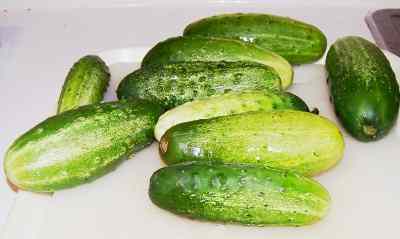 It's fun to go pick your own and you can obviously get better quality cucumbers!
It's fun to go pick your own and you can obviously get better quality cucumbers!
At right is a of picture cucumbers from my garden - they are SO easy to grow. But be sure to grow the varieties that are labeled "pickling cucumbers" - they will be much more crisp!
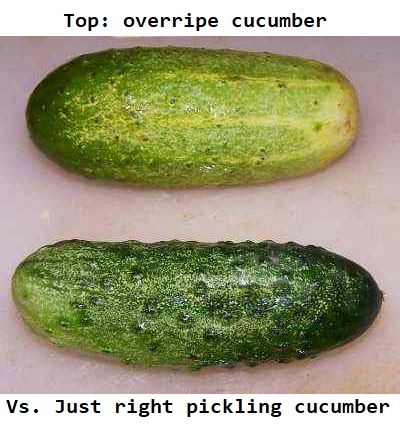 The picture at right shows a good cucumber for pickling (bottom) and a bad one (top). The good one is dark green, firm, and not bloated. It has lots of warts!
The picture at right shows a good cucumber for pickling (bottom) and a bad one (top). The good one is dark green, firm, and not bloated. It has lots of warts!
The bad one is overripe, it has yellow or white areas in the skin, and the warts are almost all gone. If you cut it open, you will see developed seeds. You don't want seeds!
Overripe cucumbers make mushy relish..
Step 2 - How many cucumbers?
It takes about 2 or 3 cucumbers per pint jar; figure about 6 pounds to make about 7 pints. Each cucumber is about 4 - 5 inches long and you will cut off the ends before chopping.
Step 3 -Wash and chop the vegetables!
I'm sure you can figure out how to wash the fruit in plain cold water.
You will need to cut the ends off (about 1/4 inch) and chop them into 1/8 to 1/4 inch pieces - or however finely you like your relish!
Chop 6 large peppers to produce 3 cups each of chopped sweet green and red peppers.
Chop 2 onions to yield 1 cup chopped onions.
Step 4 - Soak the chopped vegetables
Add chopped cucumbers, peppers, onions with the salt, and ice to water in a large bowl and let stand for 4 hours.
Step 5 - Drain
Just drain and discard the salt water.
Step 6 - Cover the vegetables with fresh ice water for another hour.
Cover the chopped veggies with fresh (unsalted) ice water and let it stand for 1 hour more.
Step 7 - Drain again.
Just drain and discard the water again.
Step 8 - Mix the spices and vinegar
Combine the 4 tsp each of mustard seed, turmeric, whole allspice, and whole cloves in a spice or cheesecloth bag. Add spices to 2 cups sugar and 6 cups white vinegar .
Step 9 - Heat the spice/vinegar mix to a boil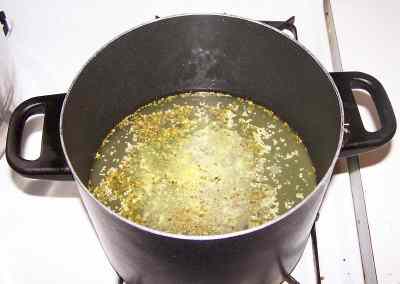
Heat to the vinegar and spice mix to a boil.
Step 10 - Pour the spice/vinegar over the chopped vegetables
Pour the spice/vinegar over the chopped vegetables and then cover and refrigerate for 24 hours, (up to 36 hours).
![]()
DAY 2
Step 11 - Get the jars and lids sterilizing

The dishwasher is fine for the jars. I get that going while I'm preparing everything else, so it's done by the time I'm ready to fill the jars. If you don't have a dishwasher, submerge the jars in a large pot (the canner itself) of water and bring it to a boil.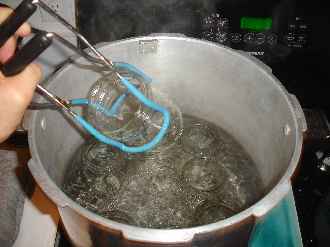
Be sure to let it go through the rinse cycle to get rid of any soap!
Get the canner heating up
Fill the canner about 1/2 full of water and start it heating (with the lid on).
Start the water for the lids
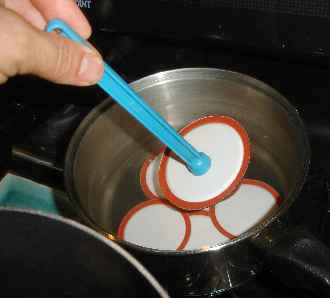 Put the lids into the small pot of boiling water for at least several minutes. Note: everything gets sterilized in the water bath (step 7) anyway, so this just helps to ensure there is no spoilage later!)
Put the lids into the small pot of boiling water for at least several minutes. Note: everything gets sterilized in the water bath (step 7) anyway, so this just helps to ensure there is no spoilage later!)


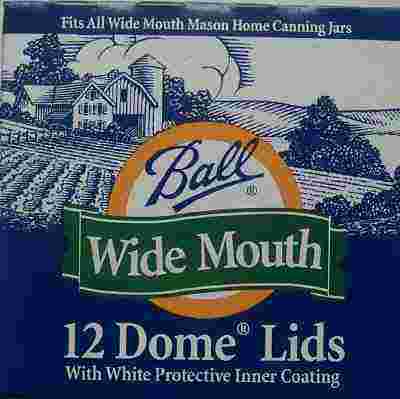 Need lids, rings and replacement jars?
Need lids, rings and replacement jars? Get them all here, delivered direct to your home, at the best prices on the internet!
Step 12 - Heat the relish for canning
Heat the relish to boiling, stirring as necessary to prevent burning.
Step 13 - Fill the jars with relish and put the lid and rings on
Fill the pint or half pint jars with the relish to within 1/4 to 1/2 inch of the top, seat the lid and hand-tighten the ring around them. (Note: larger jars are not recommended.)
Step 14 - Boil the jars in the canner
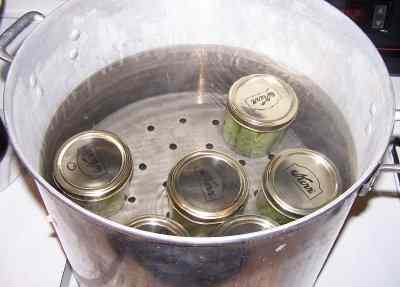 Put them in the canner and keep them covered with at least 1 inch of water. Keep the water boiling. Boil them for 10 minutes (or as directed by the instructions in the pickle mix, or with your canner). Remember to adjust for altitudes and larger jars!
Put them in the canner and keep them covered with at least 1 inch of water. Keep the water boiling. Boil them for 10 minutes (or as directed by the instructions in the pickle mix, or with your canner). Remember to adjust for altitudes and larger jars!
| Recommended process time for Pickle Relish in a boiling-water canner | ||
| Process Time at Altitudes of | ||
| 0 - 1,000 ft | 1,001 - 6,000 ft | Above 6,000 ft |
| 10 min | 15 min | 20 min |
Step 15 - Done
Lift the jars out of the water and let them cool without touching or bumping them in a draft-free place (usually takes overnight) You can then remove the rings if you like.
When can you start eating the relish? As son as the jars cool!
How long will they keep in cool, dark storage? Usually 12 to 18 months!
![]()
Other Equipment:From left to right:
|  |
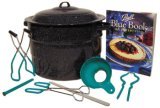 | Home Canning KitsThis is the same type of standard canner that my grandmother used to make everything from applesauce to jams and jellies to tomato and spaghetti sauce!. This complete kit includes everything you need and lasts for years: the canner, jar rack, jar grabber tongs, lid lifting wand, a plastic funnel, labels, bubble freer, and the bible of canning, the Ball Blue Book. It's much cheaper than buying the items separately. You'll never need anything else except jars and lids (and the jars are reusable). To see more canners, of different styles, makes and prices, click here! |
Summary - Cost of Making Homemade Pickles - makes 8 pint jars, 16 oz each* | ||||
| Item | Quantity | Cost in 2006 | Source | Subtotal |
| Cucumbers | 30-36 (about 3 per pint jar) | free from the garden, or $3.00 cents at a PYO | Pick your own | $3.00 |
| Canning jars (pint size, wide mouth), includes lids and rings | 12 jars | $8.00/dozen | WalMart, BigLots, Publix, Kroger | $5.35 |
| Vinegar | 6 cups | $1.20 | WalMart, Publix, Kroger | $1.20 |
| Spices | 4 teaspoons each | $3.00 per package | WalMart, BigLots, Publix, Kroger | $3.00 |
| Onion | 2 | $0.50 each | WalMart, Publix, Kroger | $1.00 |
| Pickling Salt | 3/4 cup | $3.00 per 3 cup box | WalMart, Publix, Kroger | $0.80 |
| Total | $14.35 total or about $1.80 per jar INCLUDING the jars - which you can reuse! | |||
* - This assumes you already have the pots, pans, ladles, and reusable equipment. Note that you can reuse the jars! Many products are sold in jars that will take the lids and rings for canning. For example, Classico Spaghetti sauce is in quart sized jars that work with Ball and Kerr lids and rings | ||||
How to make other pickles - recipes and instructions:
Canning processing times
Type of pickling method | Jar size | 0 to 1,000 ft above sea level | 1,001 to 6,000 ft above sea level |
| Quick process, (raw cucumbers put in the jar, hot liquid poured over them)- | pint | 10 min | 15 min |
| Quick process, (raw cucumbers put in the jar, hot liquid poured over them)- | quart | 10 min | 15 min |
Can't find the equipment? We ship to all 50 states! Use our Feedback form!
Answers to Common Questions
What did I do wrong if my pickles aren't crisp or crunchy?
You probably used overripe cucumbers or didn't measure the vinegar and water accurately. Of course, processin gtoo long in the boiling water bath can do it, too!
Why are my pickles cloudy?
There are a variety of possible causes for cloudy pickles:
In nonfermented pickles (fresh pack), cloudiness might indicate spoilage. Yeast growth may also make pickles cloudy or slimy. Check the pickles for signs of off-odors and mushiness of the pickles. If yeast growth is evident, discard the pickles. If these signs are absent, the pickles are (absent other problems) safe to eat.
Be sure to use a NON-metal pot - or a coated metal (teflon, silverstone, enamel, etc.) without breaks in the coating. the metal reacts with the vinegar and makes the pickle solution turn cloudy. This is the most common cause of cloudy pickles. There is no danger to these pickles, though!
Sometimes the fillers (anticaking agents) in regular table salt may cause slight cloudiness, so always use pickling salt. Obviously, if you used a packet mix (like Mrs. Wages) this should not be a problem.
Hard water might also cause cloudiness. If soft water is not available, boil the hard water and let it sit undisturbed overnight. Pour off the top portion and use it in the pickling solution.
When making quick process pickles, can I store any leftover pickling solution for future use?
If the pickling solution is fresh and has not been used to make pickles, cover it and store it in the refrigerator for later use. If the pickling solution has been used, it can be stored in the refrigerator and reused in a day or two for barbecue sauce, cole slaw dressing or a marinade. If mold growth occurs, throw it out.
Why did the liquid in my dill pickles turn pink?
Using overmature dill may cause this. If so, the product is still safe. However, yeast growth could also cause this. If yeast growth is evident, discard the pickles.
I don’t have the type of dill my recipe calls for. What can I substitute?
For each quart, try 3 heads of fresh dill or 1 to 2 tablespoons dill seed (dill weed = 2 tablespoons).
Can I use burpless cucumbers for pickling?
Burpless cucumbers are not recommended for use in fermented pickles. This is because at their normal mature size, they produce an enzyme that causes the pickles to soften during fermentation. However, if smaller burpless cucumbers (those with small seed) are used, they may be suitable for making fresh pack pickles.
I have an old recipe that calls for adding a grape leaf to each jar of pickles. Why?
Grape leaves contain a substance that inhibits enzymes that make pickles soft. However, if you remove the blossom end of the cucumbers (the source of undesirable enzymes) you don’t need to add grape leaves.
Why did the garlic cloves in my pickles turn green or bluish green?
This reaction may be due to iron, tin or aluminum in your cooking pot, water or water pipes reacting with the pigments in the garlic. Or, the garlic may naturally have more bluish pigment, and it is more evident after pickling. Immature bulbs should be cured two to four weeks at 70 ° F. The pickles are safe to eat.
Can I use flaked salt for pickling?
Most recipes call for granulated pickling or canning salt. Flake salt varies in density and is not recommended for pickling.
Can I safely substitute ingredients in a recipe?
I'm checking out your relish recipe, and I'm looking at many different hot pickle recipes on the web and canning info (I've never done this before, but we bought a water-bath canning kit last year). A lot of canning info says never to alter the proportions in the recipe, but I can't find one with the proportions of hot peppers to cucumbers that I want.
Could I take your relish recipe and add jalapenos or other hot peppers to make a spicy relish, or would it cause it to become unsafe because I'm altering the ratio of vegetables? Could I decrease the amount of jalapenos in a different pickle recipe (it was almost as many peppers as cucumbers, and I don't have that) and still be safe? I don't want to go through all this work and then have the stuff get us sick or be inedible. But I can't find a recipe that I like that's not flake pepper or one that uses garden peppers and a bunch of other ingredients that I don't have (other vegetables, alum... )
I guess I don't know what you can modify in a canning recipe and what you can't, and I don't want to do it wrong. And I don't have anyone to ask, because I didn't want to learn this while my aunties were still alive.
A. The short answer is no, you shouldn't change the proportions or use different ingredients
The reason the recipes say not to alter the proportions of ingredients is that may affect the pH or total acidity of the mix. The recipes (at least those on my website and the ones published by universities - were tested in laboratories with those exact proportions. They cultured the resulted and examined them to determine if there was any pathogenic activity.
By the way, don't assume that every canning recipe published in a book or online has been tested or is based on a lab tested recipe. Many are not! My recipes are based on the ones tested and published by the USDA, Ball, and the major university food science departments. For the most part, I merely took the USDA recipes, executed them verbatim, photographed the process and added more explanatory text to make them easier to follow.If you change a recipe substantially, it will affect the ability of pathogens like harmful bacteria to survive after canning.The word key is "substantially". If you replace 1 cup of blackberries in a recipe with 1 cup of raspberries, is that risky? Almost certainly not. One need not be a food scientist to know those too are closely related and probably have nearly identical properties.But what about adding 1 cup of onions to a spaghetti sauce recipe? Or peppers to a relish? That's hard to say. You'll be hard pressed to find anyone who would want to go on record to say it's ok, lest someone get sick later!Also, if you want to improve the safety of almost any canning, replace the water bath with a pressure canner. Pressure canners produce a substantially higher temperature, which kills a high percentage of a greater variety of pathogens than water bath canners.I think it's generally safe to replace like with like; hot peppers to replace green peppers, raspberries instead of blackberries, lemons instead of limes, etc. So, in your case, I think you will be fine if you substitute some of the mild peppers with an equal amount of hot peppers!
|
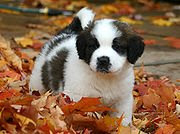
No comments:
Post a Comment